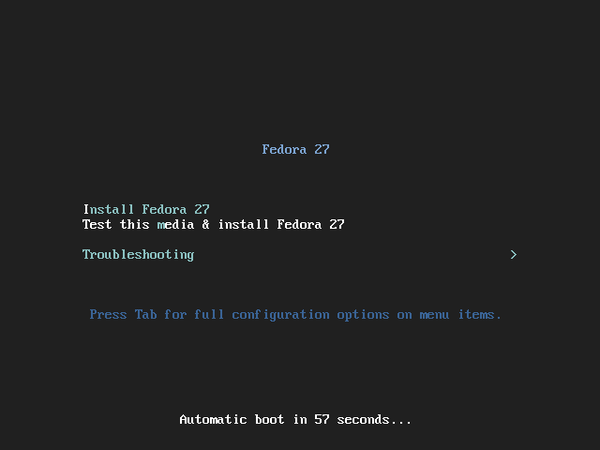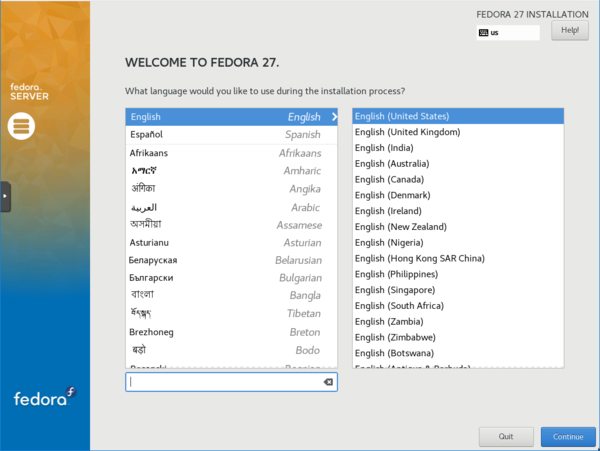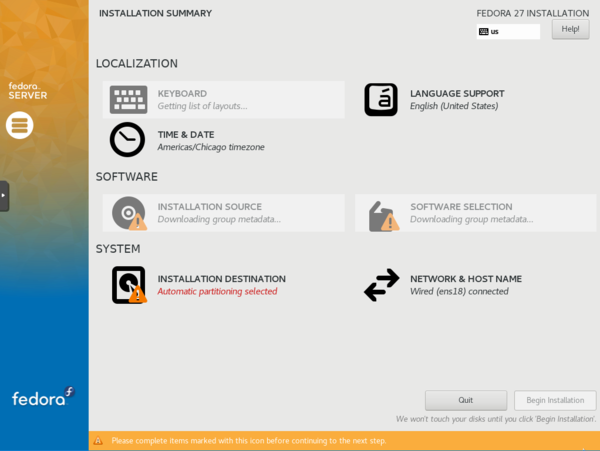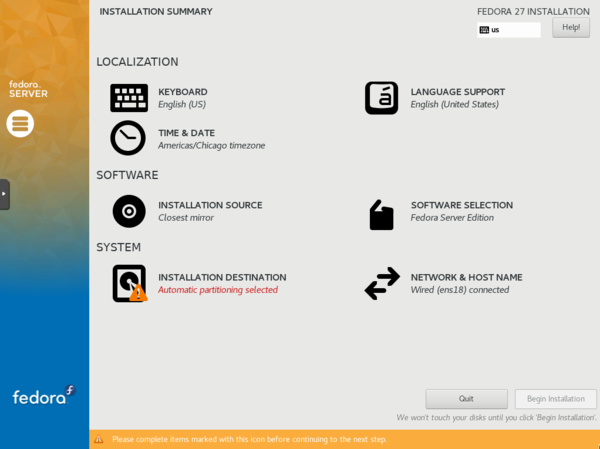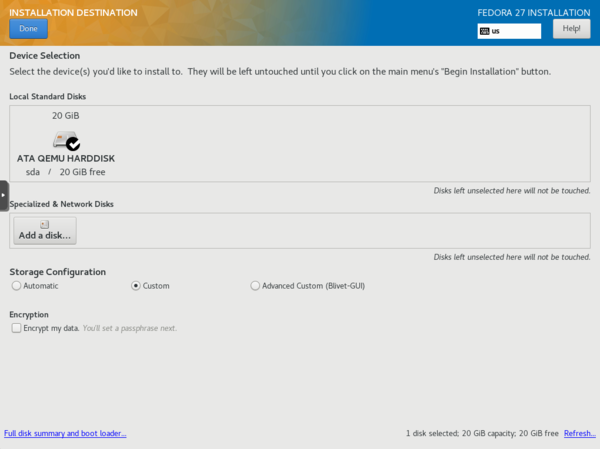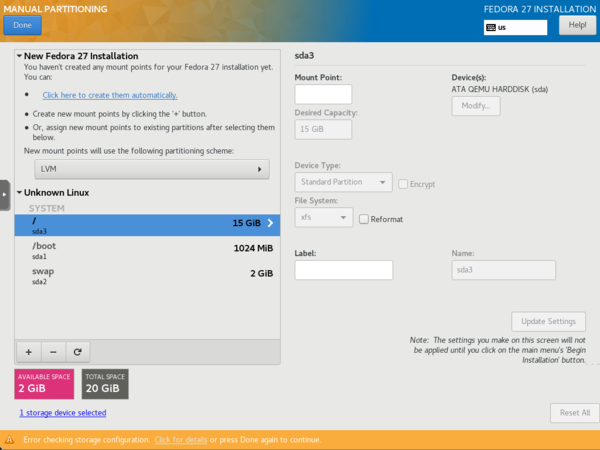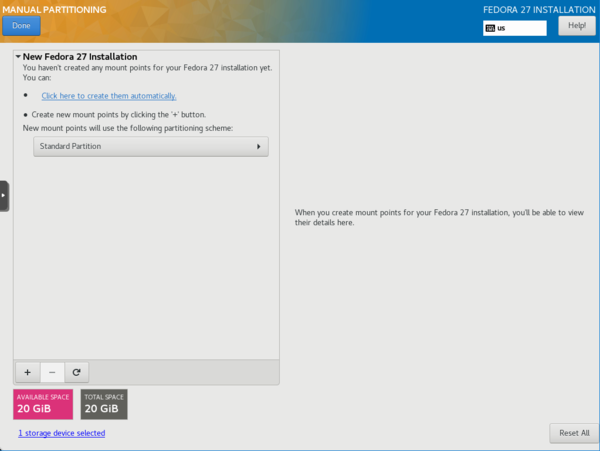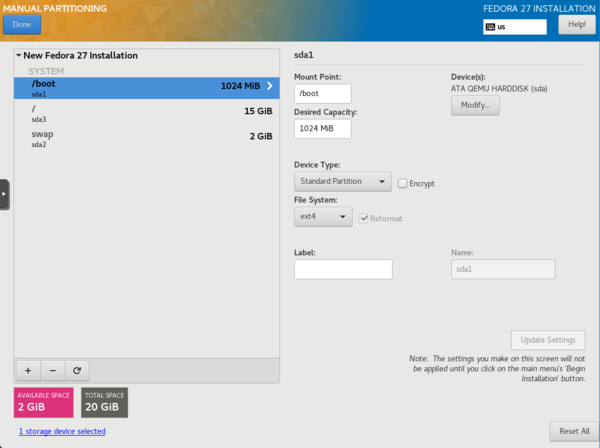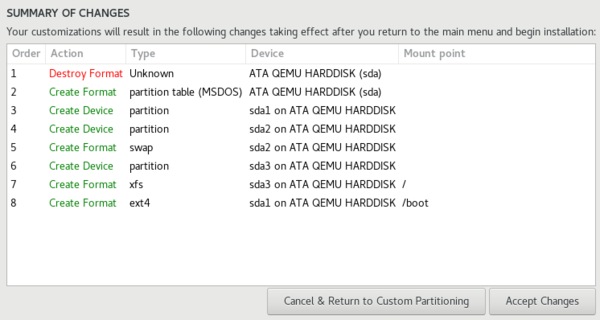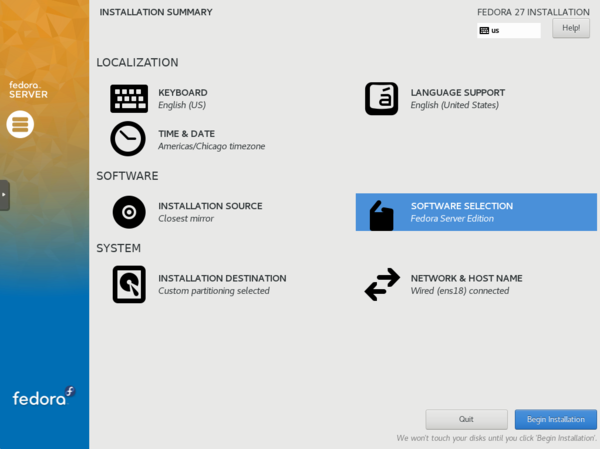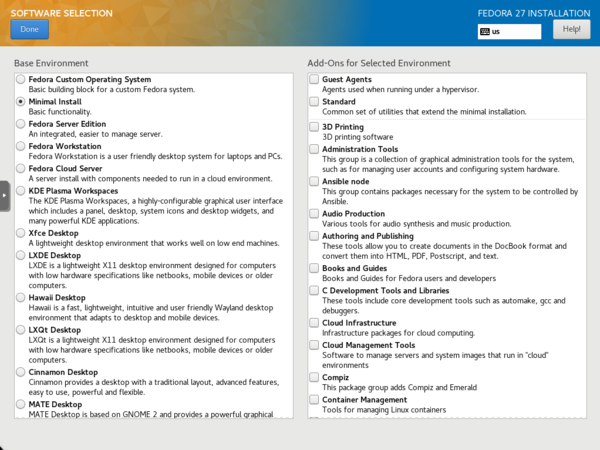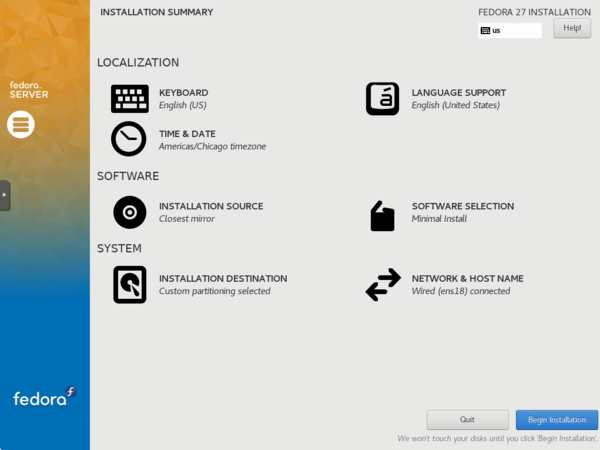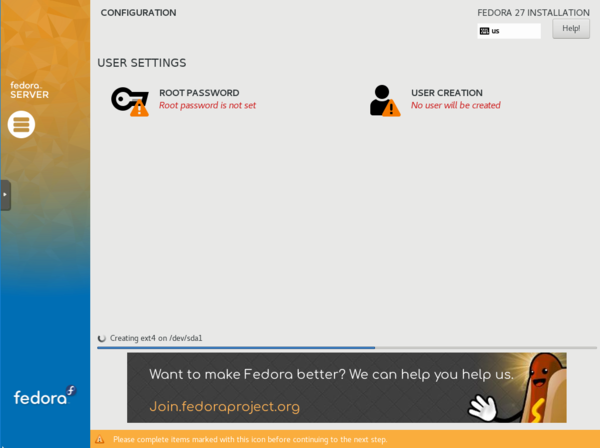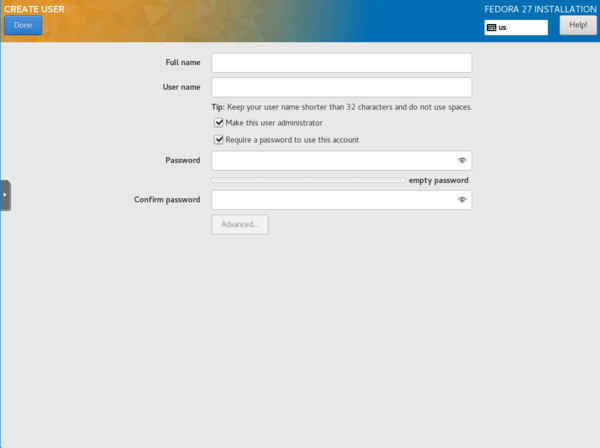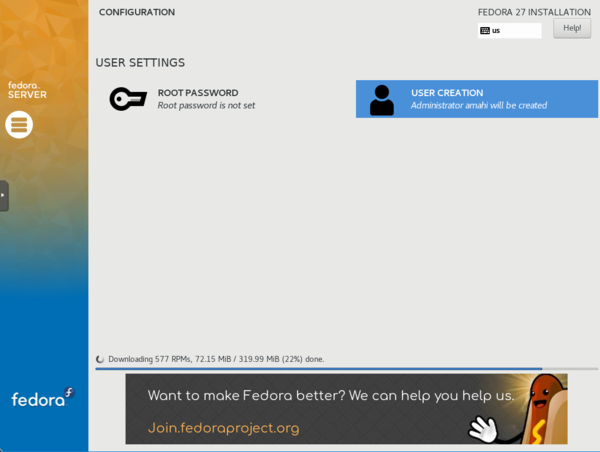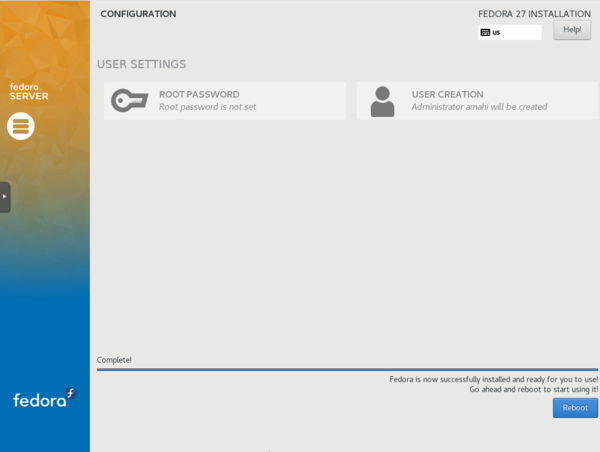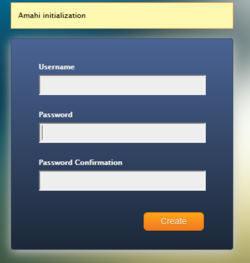Difference between revisions of "Fedora 27 Server CD Install"
| (49 intermediate revisions by 3 users not shown) | |||
| Line 1: | Line 1: | ||
| − | |||
__TOC__ | __TOC__ | ||
| − | |||
| − | |||
| − | + | = Install Fedora 27= | |
| + | This is the recommended install method. | ||
| − | + | * [https://archives.fedoraproject.org/pub/archive/fedora/linux/releases/27/Server/x86_64/iso/Fedora-Server-netinst-x86_64-27-1.6.iso Fedora-Server-netinst-x86_64-27-1.6.iso] (511MB) | |
| − | + | * Checksum: | |
| − | * [ | + | ** <code>MD5 958e27d78109c8c083fb6a0d4485e8e7</code> |
| − | + | ** <code>SHA1 e9223711ba270c2c90dd644c9b95545af062be1a</code> | |
| − | |||
| − | |||
| − | |||
| − | |||
| − | |||
| − | * | ||
| − | < | ||
| − | |||
| − | + | * Burn the ISO to CD/DVD (or [[USB Install|USB]]), insert the media into your server, and reboot the system. | |
| − | |||
| − | + | * These instructions below will guide you through the Fedora 27 Netinstall CD installation with screen shots and commentary. If you are not an advanced Linux user and know what you are doing, recommend you '''DO NOT''' deviate from the guidance. Click '''[<Screenshot>]''' to show/hide the image. | |
| − | * | ||
| − | |||
| − | |||
| − | |||
| − | |||
| − | |||
| − | |||
| − | |||
| − | |||
| − | |||
| − | |||
| − | |||
| − | |||
| − | |||
| − | |||
| − | |||
| − | |||
==Boot Screen== | ==Boot Screen== | ||
<ul> | <ul> | ||
<li>Select ''Install Fedora 27'' | <li>Select ''Install Fedora 27'' | ||
| − | <div class="mw-collapsible mw-collapsed" style="width:400px"> | + | <div class="mw-collapsible mw-collapsed" data-collapsetext="{{int:Screenshot}}" style="width:400px"> |
| − | [[file: | + | [[file:Fedora27-boot-screen.png|600px]] |
</div><br></li> | </div><br></li> | ||
</ul> | </ul> | ||
| Line 52: | Line 24: | ||
<ul> | <ul> | ||
<li>Choose desired language and select ''Continue'' | <li>Choose desired language and select ''Continue'' | ||
| − | <div class="mw-collapsible mw-collapsed" style="width:400px"> | + | <div class="mw-collapsible mw-collapsed" data-collapsetext="{{int:Screenshot}}" style="width:400px"> |
| − | [[file: | + | [[file:F27CD_SS1.PNG|600px]] |
</div><br></li> | </div><br></li> | ||
</ul> | </ul> | ||
| Line 59: | Line 31: | ||
==Installation Summary== | ==Installation Summary== | ||
<ul> | <ul> | ||
| − | <li>The '''INSTALLATION SUMMARY''' screen will appear. It may take a few minutes to finish '' | + | <li>The '''INSTALLATION SUMMARY''' screen will appear. It may take a few minutes to finish ''Checking software dependencies'' |
| − | <div class="mw-collapsible mw-collapsed" | + | <div class="mw-collapsible mw-collapsed" data-collapsetext="{{int:Screenshot}}" style="width:400px"> |
| − | + | [[file:F27CD_SS2A.PNG|600px]] | |
| − | |||
| − | |||
| − | |||
| − | [[file: | ||
</div><br></li> | </div><br></li> | ||
| − | <li> | + | |
| − | <div class="mw-collapsible mw-collapsed" style="width:400px"> | + | <li>Change the '''KEYBOARD''' or '''TIME & DATE''' to match your locale if needed.</li> |
| − | [[file: | + | <li> Verify '''NETWORK & HOST NAME''' indicates ''connected''. Don't make any changes unless you are sure of what you are doing.</li> |
| + | |||
| + | <li>Once complete, next choose ''INSTALLATION DESTINATION''. This is where you will select the disk drive to use. | ||
| + | <div class="mw-collapsible mw-collapsed" data-collapsetext="{{int:Screenshot}}" style="width:400px"> | ||
| + | [[file:F27CD_SS2B.PNG|600px]] | ||
</div><br></li> | </div><br></li> | ||
| + | </ul> | ||
| + | |||
| + | ==Disk Drive Setup== | ||
| + | <div style="border: 1px solid #A3B1BF; padding: .5em 1em; color: #000; background-color: #FFB6C1; margin: 3px 3px 1em 3px;">'''WARNING:''' Amahi staff doesn't recommend using the default ''LVM'' partition scheme. Doing so will dedicate most of the drive space in the system to the ''/home'' partition. Amahi does not utilize this space, limiting storage for file shares and web applications. For best results and maximum storage, use the ''Standard'' partition scheme.</div> | ||
| + | |||
<ul> | <ul> | ||
| − | <li>If | + | <li>Choose the disk drive you want to use for the Fedora installation. If you have more than one disk drive connected, '''DO NOT''' select them at this time. You will notice a ''check mark'' on the disk drive selected. Select ''Custom'' and then choose ''Done''. |
| − | <div class="mw-collapsible mw-collapsed" style="width:400px"> | + | <div class="mw-collapsible mw-collapsed" data-collapsetext="{{int:Screenshot}}" style="width:400px"> |
| − | [[file: | + | [[file:F27CD_SS3A.PNG|600px]] |
</div><br></li> | </div><br></li> | ||
| − | <li>Choose the | + | |
| + | <li>Should you have existing partitions on the disk drive you will be using for the Fedora 27 installation, they will have to be removed.</li> | ||
| + | <ul> | ||
| + | <li> You should see the existing partition about half way down the screen.</li> | ||
| + | <li>Choose it to expand and display the existing partitions for deletion. Select the first partition in the list followed by the minus (-) sign. | ||
| + | <div class="mw-collapsible mw-collapsed" data-collapsetext="{{int:Screenshot}}" style="width:400px"> | ||
| + | [[file:F27CD_SS3C.PNG|600px]] | ||
| + | </div></li> | ||
| + | <li> When prompted ''Are you sure you want to delete all the data on ...?'', choose ''Delete It''. | ||
| + | <div class="mw-collapsible mw-collapsed" data-collapsetext="{{int:Screenshot}}" style="width:400px"> | ||
| + | [[file:F27CD_SS3D.PNG|400px]] | ||
| + | </div></li> | ||
| + | <li> Repeat the previous two steps until all the existing partitions on the disk drive are gone.</li> | ||
</ul> | </ul> | ||
| − | <li> | + | |
| + | <li>Ensure the ''New mount points will use the following partitioning scheme:'' is changed to reflect '''Standard partition'''. Then select ''Click here to create them automatically''. | ||
| + | <div class="mw-collapsible mw-collapsed" data-collapsetext="{{int:Screenshot}}" style="width:400px"> | ||
| + | [[file:F27CD_SS3E.PNG|600px]] | ||
| + | </div><br></li> | ||
| + | |||
| + | <li>The disk drive partition should look similar to this setup. For most users, the default partitioning scheme used will suffice. However, you can manually change it using the hard drive partition scheme documentation as a guide. Once complete, choose ''Done'' | ||
| + | <div class="mw-collapsible mw-collapsed" data-collapsetext="{{int:Screenshot}}" style="width:400px"> | ||
| + | [[file:F27CD_SS3F.PNG|600px]] | ||
| + | </div><br></li> | ||
| + | |||
| + | <li>You will now see '''SUMMARY OF CHANGES''' to the disk drive. Choose ''Accept Changes'' | ||
| + | <div class="mw-collapsible mw-collapsed" data-collapsetext="{{int:Screenshot}}" style="width:400px"> | ||
| + | [[file:F27CD_SS3G.PNG|600px]] | ||
| + | </div><br></li> | ||
| + | </ul> | ||
| + | |||
| + | ==Software Selection== | ||
<ul> | <ul> | ||
| − | <li>''' | + | <li>Next on the '''INSTALLATION SUMMARY''', select ''SOFTWARE SELECTION'' |
| − | < | + | <div class="mw-collapsible mw-collapsed" data-collapsetext="{{int:Screenshot}}" style="width:400px"> |
| − | <li>''' | + | [[file:F27CD_SS4A.PNG|600px]] |
| − | </ | + | </div><br></li> |
| + | |||
| + | <li>Select ''Minimal Install'' and then choose ''Done'' | ||
| + | <div class="mw-collapsible mw-collapsed" data-collapsetext="{{int:Screenshot}}" style="width:400px"> | ||
| + | [[file:F27CD_SS4B.PNG|600px]] | ||
| + | </div><br></li> | ||
</ul> | </ul> | ||
| Line 89: | Line 100: | ||
<ul> | <ul> | ||
<li>Back to the '''INSTALLATION SUMMARY''' and ready to begin installation. Select ''Begin Installation'' | <li>Back to the '''INSTALLATION SUMMARY''' and ready to begin installation. Select ''Begin Installation'' | ||
| − | <div class="mw-collapsible mw-collapsed" style="width:400px"> | + | <div class="mw-collapsible mw-collapsed" data-collapsetext="{{int:Screenshot}}" style="width:400px"> |
| − | [[file: | + | [[file:F27CD_SS5.PNG|600px]] |
| + | </div><br></li> | ||
| + | </ul> | ||
| + | |||
| + | ==Initial User Creation== | ||
| + | <ul> | ||
| + | <li>Installation has begun and we need to create the initial user. '''DO NOT''' set the root password. | ||
| + | <div class="mw-collapsible mw-collapsed" data-collapsetext="{{int:Screenshot}}" style="width:400px"> | ||
| + | [[file:F27CD_SS6A.PNG|600px]] | ||
| + | </div><br></li> | ||
| + | |||
| + | <li>You '''MUST''' create the initial user and password (This will be your HDA Login, also called the First Admin User). Ensure you select ''Make this user administrator'' check box. Once complete, choose ''Done''. Note that a weak password may require you to select ''Done'' twice. | ||
| + | <div class="mw-collapsible mw-collapsed" data-collapsetext="{{int:Screenshot}}" style="width:400px"> | ||
| + | [[file:F27CD_SS6B.PNG|600px]] | ||
</div><br></li> | </div><br></li> | ||
</ul> | </ul> | ||
| Line 97: | Line 121: | ||
<ul> | <ul> | ||
<li>Now all of the configuration steps are complete. Sit back and watch the progress. | <li>Now all of the configuration steps are complete. Sit back and watch the progress. | ||
| − | <div class="mw-collapsible mw-collapsed" | + | <div class="mw-collapsible mw-collapsed" data-collapsetext="{{int:Screenshot}}" style="width:400px"> |
| − | + | [[file:F27CD SS7.PNG|600px]] | |
| − | |||
| − | |||
| − | |||
| − | |||
| − | |||
| − | |||
| − | |||
| − | [[file: | ||
</div><br></li> | </div><br></li> | ||
</ul> | </ul> | ||
| − | <br> | + | |
| + | ==Installation Complete== | ||
| + | <ul> | ||
| + | <li>Installation is complete. Choose ''Reboot'' and remove the installation media. | ||
| + | <div class="mw-collapsible mw-collapsed" data-collapsetext="{{int:Screenshot}}" style="width:400px"> | ||
| + | [[file:F27CD SS8.PNG|600px]] | ||
| + | </div><br></li></ul> | ||
| + | |||
| + | = Install Amahi 11 = | ||
| + | |||
| + | Next, we will install Amahi 11 proper on top of Fedora 27. | ||
| + | <ul> | ||
| + | <li>When you reboot you will see a black screen with no graphics and a "localhost login" text prompt. Login into that that console directly with the user and password you created in the Fedora 27 installation. (You can also use SSH to login remotely from a client if you know how) | ||
| + | <div class="mw-collapsible mw-collapsed" data-collapsetext="{{int:Screenshot}}" style="width:400px"> | ||
| + | [[file:A11_SS1.PNG|450px]] | ||
| + | </div><br><br> | ||
| + | |||
| + | :'''NOTE:''' Passwords do not echo characters on the screen. | ||
| + | |||
| + | <li>You need to obtain an install code (denoted YOUR-INSTALL-CODE below) from the [https://www.amahi.org/users Amahi control panel] after configuring a profile for the system you are installing, with '''proper network configuration''' for your network.<br><br> | ||
| + | |||
| + | <li>From text console or using SSH (logged in with the user created in the Fedora 27 installation), become ''root'' for the Amahi installation. When prompted for a password, it's your user password you set in the Fedora 27 install.<br /> | ||
| + | |||
| + | <div style="border: 1px solid #A3B1BF; padding: .5em 1em; color: #000; background-color: #E6F2FF; margin: 3px 3px 1em 3px; text-align: left"> | ||
| + | sudo su - | ||
| + | </div> | ||
| + | |||
| + | <li>After that, type these three separate commands (one per line, waiting for each to complete as signified by the command prompt before entering the next command) in the console. | ||
| + | |||
| + | <div style="border: 1px solid #A3B1BF; padding: .5em 1em; color: #000; background-color: #E6F2FF; margin: 3px 3px 1em 3px; text-align: left"> | ||
| + | <nowiki>rpm -Uvh http://f27.amahi.org/noarch/hda-release-11.0.0-1.noarch.rpm</nowiki> | ||
| + | dnf -y install hda-ctl | ||
| + | hda-install -i YOUR-INSTALL-CODE | ||
| + | </div> | ||
| + | </ul> | ||
| + | What this does is installs the Amahi F27 repo, gets the mariadb base packages to avoid dependency conflicts, and installs base Amahi packages (that part should install several packages). | ||
| + | |||
| + | If there are no errors, install Amahi (replace ''YOUR-INSTALL-CODE'' above with install code you got when creating a profile at [https://www.amahi.org/users your Amahi control panel]). | ||
| + | |||
| + | If all goes well, it should tell you to reboot. Go ahead and reboot! | ||
| + | |||
| + | Once reboot is complete, you should have a fully functional home server using the IP address you set up in your network! | ||
| + | |||
Next you need to transition your network to use it! | Next you need to transition your network to use it! | ||
| Line 116: | Line 174: | ||
Once installed, you will want to transition your network to using your Amahi server. Here are some of the things you should know: | Once installed, you will want to transition your network to using your Amahi server. Here are some of the things you should know: | ||
| − | + | <ul> | |
| − | + | <li>Your server will boot with the static IP you pre-configured in the Amahi control panel</li> | |
| − | + | <li>This is a headless server, therefore it will boot to a text console. There is no desktop user interface. '''Installing the Desktop (e.g. GNOME) interface will break DNS/DHCP and make the HDA as an unsuitable network server''' [[Amahi_8_Troubleshooting#Virtualization_Stack_Breaks_DNS.2FDHCP_Server|(details)]]</li> | |
| − | + | <li>It's strongly recommended you follow the [[transition to Amahi]] HDA guide to get your network fully working properly</li> | |
| − | + | <li>You can verify if the dashboard is available by accessing it from any client using the IP address of your server '''<nowiki>http://IPADDRESS/</nowiki>''' or '''<nowiki>http://hda/</nowiki>''' (in most Windows clients this works even without DNS from your HDA)</li> | |
| − | + | <li>The first time you access the dashboard, you will need to log in with user name and password you created above in the [[Fedora_27_Server_CD_Install#Initial_User_Creation|Initial user creation]] step. | |
| − | + | <div class="mw-collapsible mw-collapsed" data-collapsetext="{{int:Screenshot}}" style="width:400px"> | |
| − | + | [[file:A11-SS1.PNG|250px]] | |
| − | + | </div><br></li> | |
| − | + | <li>Once you reach your dashboard, recommend you configure your HDA [[Setup|settings]], [[Storage_and_file_sharing|create/manage shares]], [[Adding_a_second_hard_drive_to_your_HDA|add more storage space]], install apps, etc. | |
| − | + | <div class="mw-collapsible mw-collapsed" data-collapsetext="{{int:Screenshot}}" style="width:400px"> | |
| − | + | [[file:A11-SS2.PNG|400px]] | |
| − | + | </div><br></li> | |
| − | + | <li>Optionally refer to [[Greyhole#Amahi_7.2F8|Greyhole]] to install/configure storage pooling. [[RAID]] guidance is also available for advanced users.</li> | |
| + | </ul> | ||
| − | Go back to [ | + | Go back to [[Amahi_11_Install|Amahi 11 Install]] page. |
Latest revision as of 23:27, 17 November 2021
Contents
Install Fedora 27
This is the recommended install method.
- Fedora-Server-netinst-x86_64-27-1.6.iso (511MB)
- Checksum:
MD5 958e27d78109c8c083fb6a0d4485e8e7SHA1 e9223711ba270c2c90dd644c9b95545af062be1a
- Burn the ISO to CD/DVD (or USB), insert the media into your server, and reboot the system.
- These instructions below will guide you through the Fedora 27 Netinstall CD installation with screen shots and commentary. If you are not an advanced Linux user and know what you are doing, recommend you DO NOT deviate from the guidance. Click [<Screenshot>] to show/hide the image.
Boot Screen
- Select Install Fedora 27
Language Selection
- Choose desired language and select Continue
Installation Summary
- The INSTALLATION SUMMARY screen will appear. It may take a few minutes to finish Checking software dependencies
- Change the KEYBOARD or TIME & DATE to match your locale if needed.
- Verify NETWORK & HOST NAME indicates connected. Don't make any changes unless you are sure of what you are doing.
- Once complete, next choose INSTALLATION DESTINATION. This is where you will select the disk drive to use.
Disk Drive Setup
- Choose the disk drive you want to use for the Fedora installation. If you have more than one disk drive connected, DO NOT select them at this time. You will notice a check mark on the disk drive selected. Select Custom and then choose Done.
- Should you have existing partitions on the disk drive you will be using for the Fedora 27 installation, they will have to be removed.
- You should see the existing partition about half way down the screen.
- Choose it to expand and display the existing partitions for deletion. Select the first partition in the list followed by the minus (-) sign.
- When prompted Are you sure you want to delete all the data on ...?, choose Delete It.
- Repeat the previous two steps until all the existing partitions on the disk drive are gone.
- Ensure the New mount points will use the following partitioning scheme: is changed to reflect Standard partition. Then select Click here to create them automatically.
- The disk drive partition should look similar to this setup. For most users, the default partitioning scheme used will suffice. However, you can manually change it using the hard drive partition scheme documentation as a guide. Once complete, choose Done
- You will now see SUMMARY OF CHANGES to the disk drive. Choose Accept Changes
Software Selection
- Next on the INSTALLATION SUMMARY, select SOFTWARE SELECTION
- Select Minimal Install and then choose Done
Begin Installation
- Back to the INSTALLATION SUMMARY and ready to begin installation. Select Begin Installation
Initial User Creation
- Installation has begun and we need to create the initial user. DO NOT set the root password.
- You MUST create the initial user and password (This will be your HDA Login, also called the First Admin User). Ensure you select Make this user administrator check box. Once complete, choose Done. Note that a weak password may require you to select Done twice.
Installation Progress
- Now all of the configuration steps are complete. Sit back and watch the progress.
Installation Complete
- Installation is complete. Choose Reboot and remove the installation media.
Install Amahi 11
Next, we will install Amahi 11 proper on top of Fedora 27.
- When you reboot you will see a black screen with no graphics and a "localhost login" text prompt. Login into that that console directly with the user and password you created in the Fedora 27 installation. (You can also use SSH to login remotely from a client if you know how)
- NOTE: Passwords do not echo characters on the screen.
- You need to obtain an install code (denoted YOUR-INSTALL-CODE below) from the Amahi control panel after configuring a profile for the system you are installing, with proper network configuration for your network.
- From text console or using SSH (logged in with the user created in the Fedora 27 installation), become root for the Amahi installation. When prompted for a password, it's your user password you set in the Fedora 27 install.
sudo su -
- After that, type these three separate commands (one per line, waiting for each to complete as signified by the command prompt before entering the next command) in the console.
rpm -Uvh http://f27.amahi.org/noarch/hda-release-11.0.0-1.noarch.rpm dnf -y install hda-ctl hda-install -i YOUR-INSTALL-CODE
What this does is installs the Amahi F27 repo, gets the mariadb base packages to avoid dependency conflicts, and installs base Amahi packages (that part should install several packages).
If there are no errors, install Amahi (replace YOUR-INSTALL-CODE above with install code you got when creating a profile at your Amahi control panel).
If all goes well, it should tell you to reboot. Go ahead and reboot!
Once reboot is complete, you should have a fully functional home server using the IP address you set up in your network!
Next you need to transition your network to use it!
Transitioning to your Amahi server
Once installed, you will want to transition your network to using your Amahi server. Here are some of the things you should know:
- Your server will boot with the static IP you pre-configured in the Amahi control panel
- This is a headless server, therefore it will boot to a text console. There is no desktop user interface. Installing the Desktop (e.g. GNOME) interface will break DNS/DHCP and make the HDA as an unsuitable network server (details)
- It's strongly recommended you follow the transition to Amahi HDA guide to get your network fully working properly
- You can verify if the dashboard is available by accessing it from any client using the IP address of your server http://IPADDRESS/ or http://hda/ (in most Windows clients this works even without DNS from your HDA)
- The first time you access the dashboard, you will need to log in with user name and password you created above in the Initial user creation step.
- Once you reach your dashboard, recommend you configure your HDA settings, create/manage shares, add more storage space, install apps, etc.
- Optionally refer to Greyhole to install/configure storage pooling. RAID guidance is also available for advanced users.
Go back to Amahi 11 Install page.
